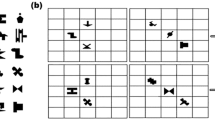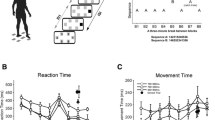Abstract
In several sequence learning studies it has been suggested that response control shifts from the stimuli to some internal representation (i.e., motor program) through the learning process. The main questions addressed in this paper are whether this control shift is related to explicit knowledge and whether the formation of these internal representations depends on the stimulus attributes. In one experiment we compared the learning of a response sequence triggered by either spatial location or location symbol (left-right) by using a serial response task (SRT). Symbols were presented at either a centered or random location. The results showed that in the symbolic conditions the shift of response control correlated with the emergence of explicit knowledge. Only participants with complete explicit knowledge seemed to learn the sequence structure beyond probabilistic information (response time "RT" did not depend on the frequency of the response). Moreover, these participants were able to overcome, when needed, spatial interference (RT was the same for both spatially corresponding and non-corresponding trials). However, when spatial location was relevant, RT was always faster, especially for more frequent responses. These results suggest that the relevant stimulus dimension (location or symbol) seems to engage different sequence learning mechanisms.



Similar content being viewed by others
Notes
We thank Iring Koch for his suggestion for similar analyses involving the sequence structure.
A pilot study showed that explicit learning was very difficult to obtain in this condition even with intentional instructions (only one-third of the participants were able to write the complete sequence).
This effect was only marginal in the first random block (p=0.08), probably due to a longer RSI (250 ms) than that observed for the response repetition effect (50 ms).
References
Baker, J.T., Donoghue, J.P., & Sanes, J.N. (1999). Gaze direction modulates finger movement activation patterns in humans. Journal of Neuroscience, 15, 10044–10052.
Bertelson, P. (1965). Serial choice reaction time as a function of response versus signal and response repetition. Nature, 205, 217–218.
Bower, G. H., & Winzenz, D. (1969). Group structure, coding, and memory for digit sequences. Journal of Experimental Psychology Monograph Supplement, 80, 1–17.
De Jong, R., Liang, C.C., & Lauber, E. (1994). Conditional and unconditional automaticity: A dual-process model of effects of spatial stimulus-response correspondence. Journal of Experimental Psychology: Human Perception and Performance, 20, 731–750.
Eimer, M., Hommel, B., & Prinz, W. (1995). S-R compatibility and response selection. Acta Psychologica, 90, 301–313.
Eliassen, J.C., Souza, T., & Sanes, J.N. (2001). Human brain activation accompanying explicitly directed movement sequence learning. Experimental Brain Research, 141, 269–280.
Frensch, P. A. (1994). Composition during serial learning: a serial position effect. Journal of Experimental Psychology: Learning, Memory and Cognition, 20, 423–442.
Frensch, P. A., & Miner, C. S. (1994). Effects of presentation rate and individual differences in short-term memory capacity on an indirect measure of serial learning. Memory and Cognition, 22, 95–110.
Hazeltine, E., Grafton, S. T., & Ivry, R. (1997). Attention and stimulus characteristics determine the locus of motor-sequence encoding. A PET study. Brain, 120, 123–140.
Helmuth, L. L., Mayr, U., & Daum, I (2000). Sequence learning in Parkinson's disease: a comparison of spatial attention and number-response sequences. Neuropsychologia, 38, 1143–1451.
Hoffmann, J., & Koch, I. (1997). Stimulus-response compatibility and sequential learning in the serial reaction time task. Psychological Research, 60, 87–97.
Hoffmann, J., & Koch, I. (1998). Implicit learning of loosely defined structures. In M. A. Stadler, & P. A. Frensch (Eds.). Handbook of implicit learning. Thousand Oaks, CA: Sage.
Hommel, B. (2003). Acquisition and control of voluntary action. In S. Maasen, W. Prinz, & G. Roth (Eds.) Voluntary action: Brains, minds, and sociality (pp. 34–48). Oxford: Oxford University Press.
Koch, I., & Hoffmann, J. (2000a). The role of stimulus-based and response-based spatial information in sequence learning. Journal of Experimental Psychology: Learning, Memory, and Cognition, 26, 863–882.
Koch, I., & Hoffmann, J. (2000b). Patterns, chunks, and hierarchies in serial reaction-time tasks. Psychological Research, 63, 22–35.
Lashley, K. S. (1951). The problem of serial order in behavior. In L. A. Jeffress (Ed.), Cerebral Mechanisms in Behavior. The Hixon Symposium (pp. 112–136). New York: Wiley.
Lawrence, B. M., Myerson, J., Oonk, H. M., & Abrams, R. A. (2001). The effects of eye and limb movements on working memory. Memory, 9, 433–444.
Logie, R. H. (1995). Visuo-spatial working memory. Hillsdale, NJ: Erlbaum.
Lu, C. H., & Proctor, R.W. (1995). The influence of irrelevant location information on performance: a review of the Simon and spatial Stroop effects. Psychonomic Bulletin & Review, 2, 174–207.
Mayr, U. (1996). Spatial attention and implicit sequence learning. Evidence for independent learning of spatial and non-spatial sequences. Journal of Experimental Psychology: Learning, Memory and Cognition, 22, 350–364.
Nattkemper, D., & Prinz, W. (1997). Stimulus and response anticipation in a serial reaction task. Psychological Research, 60, 98–112.
Notebaert, W., Soetens, E., & Melis, A. (2001). Sequential analysis of a Simon task—evidence for an attention-shift account. Psychological Research, 65, 170–184.
Posner, M. I. (1992). Attention as a cognitive and neural system. Psychological Science, 1, 11–14.
Posner, M. I., & Rothbart, M. (1992). Attentional mechanisms and consciousness experience. In A. D. Milner, & M. D. Rugg (Eds.), The Neuropsychology of Consciousness (pp. 91–111). San Diego, CA: Academic Press.
Proctor, R. W., Wang, H., & Kim-Phoung L. (2002). Influences of different combinations of conceptual, perceptual, and structural similarity on stimulus-response compatibility. The Quarterly Journal of Experimental Psychology, 55A, 59–74.
Rosenbaum, D. A., Kenny, S. B., & Derr, M. A. (1983). Hierarchical control of rapid movement sequences. Journal of Experimental Psychology: Human Perception and Performance, 9, 86–102.
Simon, J. R., & Small, A.M., Jr. (1969). Processing auditory information: Interference from an irrelevant cue. Journal of Applied Psychology, 53, 433–435.
Willingham, D. B. (1998). A neuropsychological theory of motor skill learning. Psychological Review, 105, 558–584.
Willingham, D. B., Nissen, M. J., & Bullemer, P. (1989). On the development of procedural knowledge. Journal of Experimental Psychology: Learning, Memory and Cognition, 15, 1047–1060.
Zirngibl, C., & Koch, I. (2002). The impact of response mode on implicit and explicit sequence learning. Experimental Psychology, 49, 153–162.
Acknowledgements
We thank Herbert Heuer, Iring Koch, Ulrich Mayr, and Bernhard Hommel for their helpful suggestions on a previous draft of this paper. We also thank Ivan Rodríguez for his assistance in running the experiment and Chris Chizk for checking the English. This research has been supported by the Ministerio de Ciencia y Tecnología of the Spanish Government (BSO2001-2008 and BSO2001-3264).
Author information
Authors and Affiliations
Corresponding author
Rights and permissions
About this article
Cite this article
Tubau, E., López-Moliner, J. Spatial interference and response control in sequence learning: the role of explicit knowledge. Psychological Research 68, 55–63 (2004). https://doi.org/10.1007/s00426-003-0139-4
Received:
Accepted:
Published:
Issue Date:
DOI: https://doi.org/10.1007/s00426-003-0139-4




